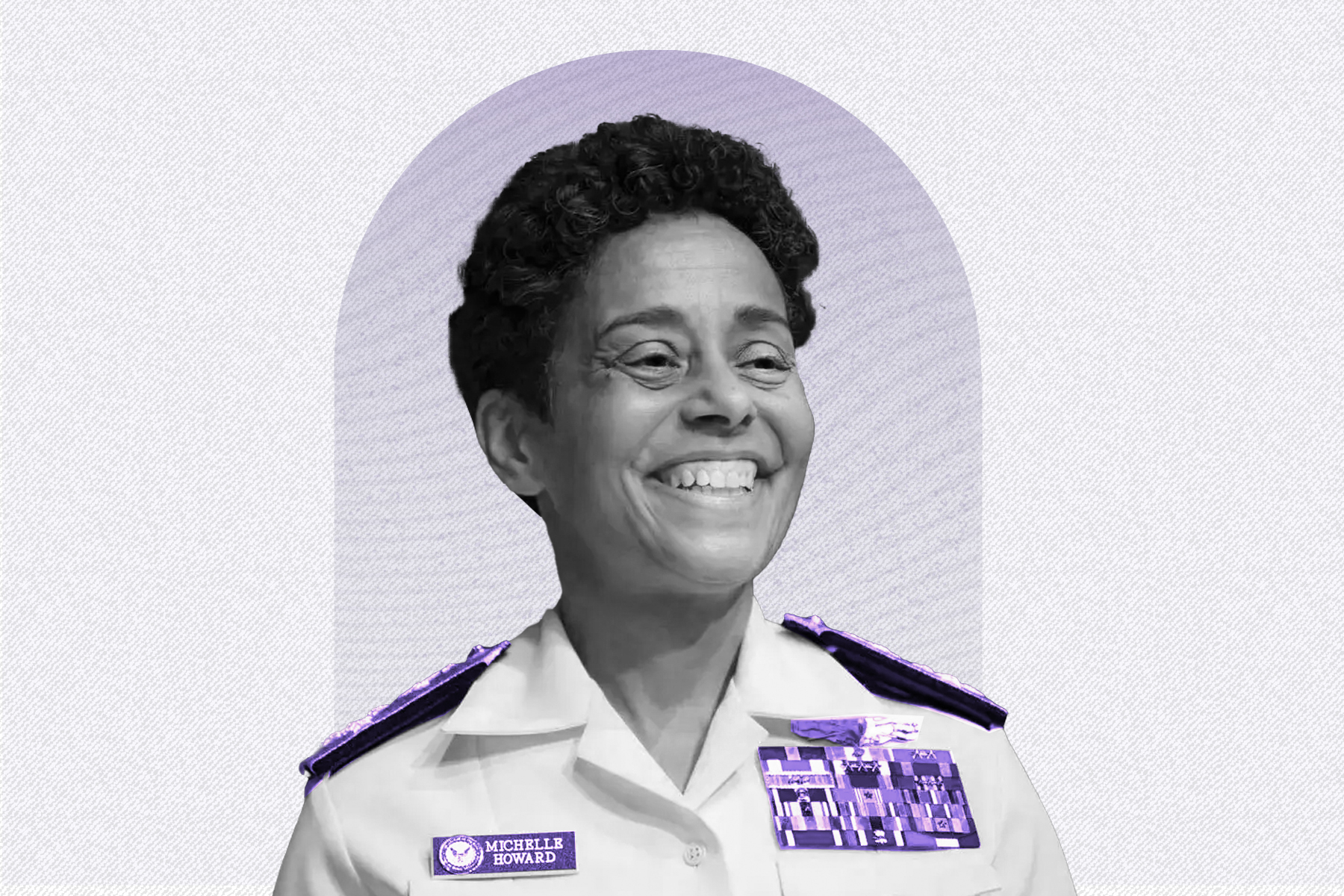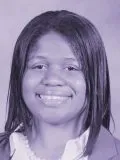President Harry S. Truman famously desegregated the United States armed forces, issuing Executive Order 9981 on July 26, 1948, to abolish discrimination against Black service members. Less acknowledged in history was another law he signed that year, the Women’s Armed Services Integration Act passed by Congress, that allowed women to serve as regular members of all the major branches of the armed forces.
The Truman Library Institute marked the 75th anniversary of the military’s integration last week, inviting President Joe Biden but also Adm. Michelle Howard, the first woman to reach the rank of four stars in the U.S. Navy and the first Black woman to reach three- and four-star rankings in the armed forces.
As a child who grew up in a military family, Howard said she knew early on that she wanted to become an officer. But even as a child in the 1970s she saw that many doors to that path remained closed to her. It was not until the Vietnam War, nearly a decade after Truman’s executive order, that White and Black soldiers were fully integrated. The Women’s Armed Services Integration Act initially barred women from becoming admirals and generals. And the military service academies — the most direct path to becoming an officer — were still closed to women.
By the time she was in high school, though, that would change, allowing her to attend the Naval Academy in Annapolis, Maryland.
As Howard notes, even after Truman’s actions, it took people who were willing to continue to push open the door for change — people like herself. The 19th recently spoke to Howard about what these historic anniversaries mean to her and why she hopes people will use these commemorations to educate themselves about the ongoing work that is left to be done.
This interview has been edited for length and clarity.
Rebekah Barber: As you celebrate the 75th anniversary of desegregation in the military, what are you most looking forward to? What does it mean to you, specifically, as a Black woman?
Adm. Michelle Howard: It’s seminal. When you think about Truman’s executive order to integrate the armed forces, if that hadn’t happened, I wouldn’t be here.
This is also the 75th anniversary of the Women’s Armed Forces Integration Act, which allowed women to serve on active duty for the first time in the history of the military. And if that hadn’t happened, I wouldn’t be here.
This is an opportunity to educate. If you think about the impact of Truman’s executive order, in reality, the fruition of all of that didn’t happen right away. It was literally, in some cases, not just years but decades.
It’s a time to educate — to remind us how recent all of this has been. For example, with the Women’s Armed Forces Integration Act when it first came out, women were not allowed to be admirals and generals.
That part of the law was repealed in ’67. In ’72, I’m 12, and I want to go to the service academy. They’re closed to women by law. That changes in ’76, and I started Annapolis in ’78.
If the law hadn’t changed, and it changed within my lifetime, the opportunities for women and people of color would have been nonexistent.
You come from a military family. Did you always know that you wanted to go into the armed forces and make a difference and pave the way for other women?
I was pretty young when I said that’s what I want to do. I saw this documentary, and I just knew I wanted to go to a service academy.
My older brother busted my bubble by saying, “You can’t go. They’re closed to women by law.”
I go to my mom, and she says, “Well, you’re just 12. You could change your mind,” which I didn’t think I would.
And she said, “When you’re old enough, if you still want to do it, apply. If you’re rejected because you’re a woman, we’ll sue the government.”
She gave me this idea of persistence and trying to do the right thing. Luckily for me, the law changed.
When I was first starting, women were only allowed to serve on the hospital ship in the Navy. This entire career I had — starting in support ships, moving into ships that have previously been closed, amphibious ships — none of that was possibly in my mind that I was going to be at the forefront of the chain.
I don’t think any of us — any of the women who started the service academies in those years — thought about a lifetime career or any one of us being the trailblazer.
How did you decide that you specifically wanted to go into the Navy?
A lot had to do with bias and prejudice.
The service academies had just opened. I go to my high school counselor, and he says, “I’m not going to help a girl get in there.”
So, I went to the library — this is pre-internet. The academies had these great books on how you apply, but also on what you can do once you graduate.
For the Naval Academy, you could go into the Marine Corps. I figured out that anything I could do in the Marine Corps was the same as what I could do at West Point, going into the Army. Anything I could do in the Air Force, including flying, I could do coming out of Annapolis and going into aviation if I qualify.
I felt at that point that Annapolis gave me the most options. I put it as my No. 1 pick.
What were your experiences with racism and sexism in the Navy like? How did you overcome them?
Let me start with the sexism. The first few year groups at the service academies, it’s the ’70s, and we’re going through some big societal changes.
About the time I’m starting Annapolis, Sandra Day O’Connor is the first woman justice. Sally Ride doesn’t exist in the public consciousness yet. Women are just breaking into law enforcement and firefighting.
You think about ’72 — the ERA and women marching in the street — it was a big time of societal change.
Annapolis had been an all-male institute. The men were angry and frustrated. The women were at the receiving end of all that anger and frustration. For us, the first part was just trying to get through those first four years.
Then while I was there, ships opened up, support ships opened up to women. When I graduated in ’82, I went straight to sea.
It was the same thing. Now you’re at the very forefront of cultural change. Policies have to be adjusted, but for the most part, it’s the mindset of the crews and the officers that have to adjust.
The only way to do that is to go onboard a ship and just be the best officer you can be.
What was it like to board these ships and enter these spaces where there hadn’t been any Black women — or any women at all — before?
For me, there was an appreciation of those who came before me. I have to remind people I may have been the first to succeed, but I wasn’t the first to try.
There’s a group of women who’ve been pushing these boundaries. There’s a small group of women of color who’ve been pushing at these boundaries before I came along, and I happened to be the one to break through it.
It made me realize that with change, the door gets pushed open slowly — almost one person at a time. Sooner or later, it’s wide enough that somebody gets through it.
I think about the history of the Navy and the changes that were happening. When I was 12, I wanted to go to Annapolis. That’s the year the Navy had its first African-American admiral, Rear Admiral [Samuel] Gravely.
All of these changes were new to the Navy, and during that time frame, the Navy was still dealing with its own struggles to integrate.
Black carriers were having sit-ins because they weren’t being treated the same.
It’s the bravery of some of the leadership at the time, like Secretary [John W.] Warner, who was the secretary of the Navy at the time. It was CNO [Adm. Elmo Zumwalt Jr.], one of my heroes, who said, “We’re gonna take this on. You’re gonna change your mindset, or you’re gonna get out.”
And then Zumwalt forcefully said, “There are no Black sailors, there are no White sailors, there are just sailors.”
It takes a generation to not just say that, but for people to believe that and to start behaving that way.
When you’re at that cusp of behavior change, it’s hard on all of you. It’s hard on the people who just want to be patriotic and serve their country. It’s hard on the people who’ve been serving their country and aren’t used to working with someone who looks like you.
Once you walked through these doors, how did you strive to hold the door open for those coming behind you?
Some of it is creating this connectivity between people with shared experiences. In my case, that started pretty early.
I had been in the Navy for about seven years. I was a lieutenant. I’m on an ammunition ship as the chief engineer. One of my former roommates, Jan, she’s at a ROTC unit.
She said, “Hey, there are more women on the waterfront than ever. We need to help these women midshipmen from ROTC, from Annapolis, start to understand what’s going on and what the opportunities are.” She said, “Let’s just put on a symposium.”
We ended up with 150 women — midshipmen, active duty and some Coast Guard women.
We had an all-day symposium, and we found we could create our own opportunities to share wisdom on how to be successful.
Then I just kept that up. If I would go somewhere, I would throw what I would call a “women at sea” party. My husband and I would get to our house, and we’d say, “We don’t care what community you are — supply corps, chaplain, aviator. If you served at sea, let’s get together.”
I refer to it as the modern-day version of a quilting bee. Women on the frontier used to get together and put these quilts together. It wasn’t about the quilts. It’s about wisdom.
You said that this 75th anniversary of the desegregation of the armed forces,as well as the 75th anniversary of the Women’s Armed Services Integration Act should be an opportunity to educate. Is there a lesson that really stands out to you?
It’s an ancient proverb: “After enlightenment, there is still laundry.”
After you have a significant change in the law, after there’s a significant policy change, there’s still a lot of daily work that has to be done.
Down to the individual level, there’s still work to be done in order to make that law come to life. Persistence and commitment are probably the most fundamental character traits anybody’s going to need if they’re going to be in a trailblazing situation.







